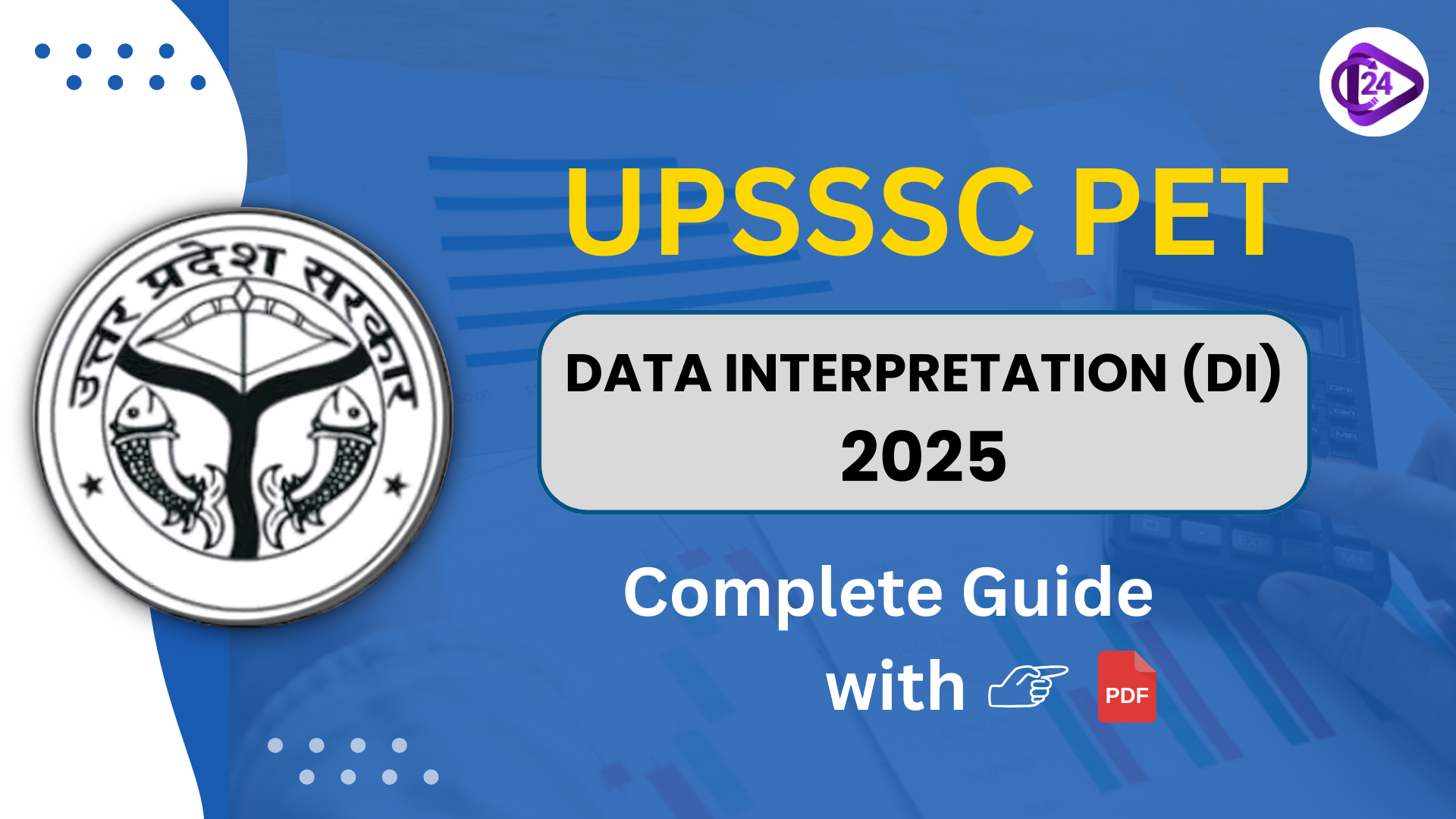The UPSSSC PET exam includes Data Interpretation (DI) to measure a candidate’s calculation, observation and reasoning skills. Typically, you will find data shown in tables, graphs, charts or lines, with the related questions appearing below. Most of the questions are not too complicated and understanding percentages, averages and ratios can allow candidates to get full scores. Because DI scores very highly for accuracy, focusing on it is essential. DI usually appears in the UPSSSC PET exam which means you risk a low score if you skip it.

Data Interpretation (DI) requires you to keep practicing it. You should work on solving problems from all types of DI charts such as table-based, bar chart, pie chart and line graph. Go over the basics in arithmetic first, then try working on questions that have calculators. Using a timer while studying and practicing answers to mock questions improves your speed and ability to stay on track in real exams. Using books such as R.S. Aggarwal and Fast Track Arithmetic helps with understanding math, yet you can also access helpful practice papers on Class24. With DI, improvement comes from regular problem-solving – the more you practice, the easier it gets.
UPSSSC PET 2025 Exam Overview
The UPSSSC PET (Preliminary Eligibility Test) is planned for August 2025. The Uttar Pradesh Subordinate Services Selection Commission administers this exam as a necessary test for many positions in Group C. The exam serves to choose suitable candidates for high-profile roles including Lekhpal, Junior Assistant and Forest Guard.
Data Interpretation (DI) is an important and scoring section of the UPSSSC PET exam. Here, candidates are rated on how quickly they handle math, eye for details and how well they analyze things. Knowing Data Interpretation well can greatly increase your overall score, so it’s very important to focus on it during your preparation.
| Exam Parameter | Details |
|---|---|
| Exam Name | UPSSSC Preliminary Eligibility Test (PET) 2025 |
| Conducting Authority | Uttar Pradesh Subordinate Services Selection Commission (UPSSSC) |
| Exam Date | Expected in August 2025 |
| Exam Type | Offline (Pen and Paper) |
| Level | State-level |
| Number of Questions | Approximately 100 |
| Total Marks | 100 |
| Duration | 2 Hours |
| Important Sections | General Knowledge, Arithmetic, General Hindi, Data Interpretation (DI) |
| Purpose | Qualifying test for Group C recruitment posts like Lekhpal, Junior Assistant, Forest Guard, etc. |
Free UPSSSC PET DI Practice Sets – PDF Download
Preparing with several DI questions is vital for doing well in the UPSSSC PET DI section. This free resource contains over 50 + practice sets and proper answers for Data Interpretation problems.
- Questions grouped by topic for learning to interpret table, bar graph, pie chart and line graph data.
- Answers for every question are written with detailed steps.
- Timed exercises to boost your exam speed
What is Data Interpretation (DI) in UPSSSC PET?
Data Interpretation (DI) covers topics where students need to work with data shown in charts, tables, graphs or diagrams. The data should guide you in answering some related questions. Here, you must show your skill in understanding, analyzing and interpreting the information you see. You should rely on your observational, calculation and reasoning abilities to answer the questions.
Most DI questions in the UPSSSC PET exam are easy to moderate in difficulty. If you know the basic ideas of arithmetic well, you can expect to do well and gain 2 to 3 points from this section.
UPSSSC PET Data Interpretation Syllabus 2025: Detailed Topics
The UPSSSC PET Data Interpretation syllabus covers common question formats seen in the exam. Being aware of these subjects will assist candidates in preparing better and doing well on the DI section.
- Table-Based Data Interpretation
- Bar Graphs Interpretation
- Pie Charts Analysis
- Line Graphs Interpretation
- Mixed Graphs (combination of table and graph or pie and table)
- Percentage-Based Data Interpretation
- Ratio & Proportion-Based DI Questions
| DI Topic | Expected Number of Questions | Difficulty Level |
|---|---|---|
| Table-Based DI | 1 | Easy |
| Bar Graph | 1 | Easy to Moderate |
| Pie Chart | 1 | Moderate |
| Line Graph | 0–1 | Moderate |
| Mixed Graph | 0–1 | Moderate |
Note: UPSSSC PET includes some Data Interpretation questions within the Numerical Ability section, with usually 2 to 3 such questions present.
Types of Data Interpretation Questions in UPSSSC PET Exam
You should learn how different types of Data Interpretation questions appear in the UPSSSC PET exam to improve your performance.
1. Table-Based Data Interpretation
Most DI problems follow the table format, so data is presented by rows and columns. In solving problems, candidates calculate totals, average figures, percentages and compare them.
Example:
| Year | Revenue (in ₹ lakhs) |
|---|---|
| 2020 | 120 |
| 2021 | 150 |
| 2022 | 180 |
Question: Calculate the average revenue over these three years.
Answer: (120 + 150 + 180) / 3 = ₹150 lakhs
2. Bar Graph Interpretation
Bar graphs show different amounts by using short or tall rectangular bars. DI problems about bar graphs are often concerned with finding percent changes or value differences among various groups.
3. Pie Chart Interpretation
A pie chart clearly shows data in terms of its share of the whole. Questions need you to perform calculations using the angles or percentages seen on the chart.
4. Line Graph Interpretation
Line graphs reveal how things change as time goes by. Most questions want you to examine how different values have increased, decreased or changed over time.
5. Mixed Graphs
There are times when DI points out both bar and table graphs or pie and line graphs, so students must do several calculations and interpretations at once.
Best Books for UPSSSC PET Data Interpretation Preparation
Studying with the appropriate books can help you do better in UPSSSC PET Data Interpretation questions. Let us look at some excellent books and websites for learning DI.
| Book Name / Platform | Author/Publisher | Why It’s Useful for DI Preparation |
|---|---|---|
| Quantitative Aptitude | R.S. Aggarwal | Covers DI basics with numerous solved examples and practice sets |
| Fast Track Objective Arithmetic | Rajesh Verma | Simplifies concepts with shortcut tricks and DI practice questions |
| Lucent Objective Mathematics | Lucent | Contains competitive level DI questions for UPSSSC exams |
| Class24 UPSSSC PET Course | Class24 | Offers exclusive video lectures, topic-wise DI practice sets, and mock tests specially curated for UPSSSC PET aspirants |
Class24’s UPSSSC PET Online Course is ideal for those looking to master Data Interpretation questions with expert guidance, Hindi-medium content, doubt support, and daily live practice sessions.
Solving UPSSSC PET DI mock tests and earlier questions will improve your speed, ability to answer questions correctly and give you more confidence when taking the exam.
How to Prepare for UPSSSC PET Data Interpretation – Expert Tips
Follow these methods to prepare for the UPSSSC PET Data Interpretation section and get the best marks.
Master Basic Concepts: Be sure to grasp percentages, ratios, averages and proportions well.
Practice Daily: Make sure to answer 2 to 3 different DI question sets daily that include tables, bar graphs, pie charts and line graphs.
Improve Calculation Speed: You can calculate more quickly if you use BODMAS, learn m touching tips for math and memorize multiplication tables.
Develop Graph Reading Skills: Practice quickly and effectively in understanding different types of graphs.
Time Yourself: Make sure you complete a DI set in ten minutes or less to boost your speed under testing conditions.
Take Mock Tests: Try to take as many proper full-length mock tests as possible to notice what can be done to improve your weak spots.






Your email address will not be published. Required fields are marked *